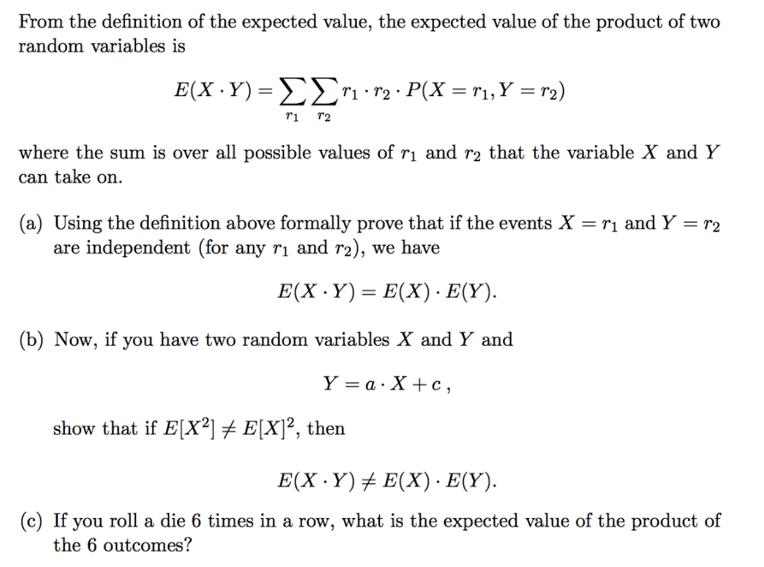Question
From the definition of the expected value, the expected value of the product of two random variables is E(X+Y)=r r P(X = T, Y

From the definition of the expected value, the expected value of the product of two random variables is E(X+Y)=r r P(X = T, Y = r) 72 r1 r2 where the sum is over all possible values of r and r2 that the variable X and Y can take on. (a) Using the definition above formally prove that if the events X = r and Y = r2 are independent (for any r and r2), we have E(XY)= E(X). E(Y). (b) Now, if you have two random variables X and Y and Y = a.X+c, show that if E[X2] + E[X], then E(XY) E(X). E(Y). (c) If you roll a die 6 times in a row, what is the expected value of the product of the 6 outcomes?
Step by Step Solution
3.36 Rating (174 Votes )
There are 3 Steps involved in it
Step: 1
a T1 T2 PX r Y r r1 r2 EXY r1r2 r1 r2 ...
Get Instant Access to Expert-Tailored Solutions
See step-by-step solutions with expert insights and AI powered tools for academic success
Step: 2

Step: 3

Ace Your Homework with AI
Get the answers you need in no time with our AI-driven, step-by-step assistance
Get StartedRecommended Textbook for
Discrete Mathematics and Its Applications
Authors: Kenneth H. Rosen
7th edition
0073383090, 978-0073383095
Students also viewed these Accounting questions
Question
Answered: 1 week ago
Question
Answered: 1 week ago
Question
Answered: 1 week ago
Question
Answered: 1 week ago
Question
Answered: 1 week ago
Question
Answered: 1 week ago
Question
Answered: 1 week ago
Question
Answered: 1 week ago
Question
Answered: 1 week ago
Question
Answered: 1 week ago
Question
Answered: 1 week ago
Question
Answered: 1 week ago
Question
Answered: 1 week ago
Question
Answered: 1 week ago
Question
Answered: 1 week ago
Question
Answered: 1 week ago
Question
Answered: 1 week ago
Question
Answered: 1 week ago
Question
Answered: 1 week ago
Question
Answered: 1 week ago
Question
Answered: 1 week ago
Question
Answered: 1 week ago
Question
Answered: 1 week ago
Question
Answered: 1 week ago
View Answer in SolutionInn App



